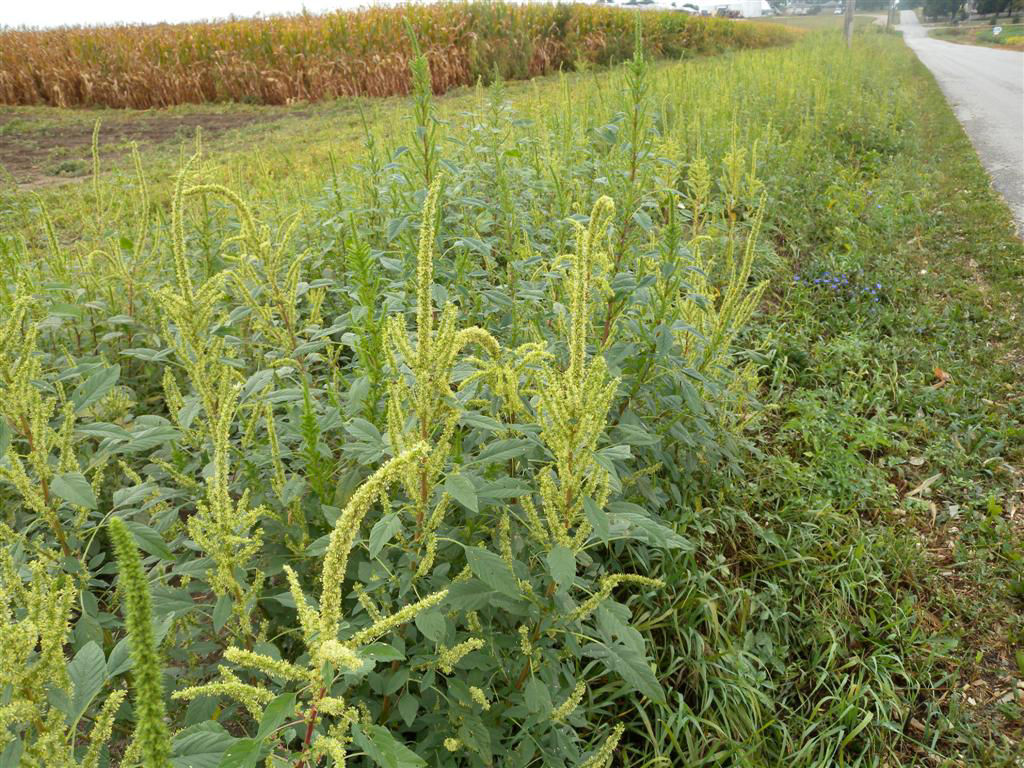5 MIN READ
Palmer Amaranth – Identification and Management
July 30, 2020
Identification
Palmer amaranth is a native weed species that originated in the Southwest, but over time, has migrated across the United States and now can be found in most Corn Belt states (Figure 1). It is a very invasive species as it produces hundreds of thousands of seeds per plant that are easily spread by wind, water equipment, and animals. Palmer amaranth is a member of the pigweed family and can often be confused with other pigweeds such as redroot pigweed and waterhemp. Palmer amaranth and waterhemp are often misdiagnosed because both have a smooth hairless stem, but the leaf structure is different. Palmer amaranth has a petiole that is longer than the leaf when folded over. This long petiole makes distinguishing between Palmer amaranth and waterhemp quick and easy in the field.

Early identification and management of Palmer amaranth is very important in controlling the spread of this pest. It has shown the ability to adapt to environments, cross pollinate with other pigweed species, and develop tolerance and resistance to key herbicides.
Management
- Identification – Identification is more than identifying the species but also includes evaluating size of the population, the size of the plants (for control purposes), and population locations.
- Develop a control plan – depending on the size of the population and the size of the actual plants can help determine the best control plan. Tillage, herbicides, and hand removal are the most effective means of keeping Palmer amaranth under control.
a. Tillage – The most effective way to remove small plants is using a field cultivator, row cultivator, plow, or chisel plow to uproot or bury the plants which kills them and prevents them from growing and producing seed. Other tillage practices, such as vertical tillage or using a disk, usually fail to kill the plant and allows them to grow back.
b. Herbicides – using herbicides to control Palmer amaranth can be very effective; however, the plants need to be controlled when they are small (under 4 inches tall). As the plant becomes larger, herbicide control becomes less effective and increases the potential for the development of herbicide resistance. Consult with your herbicide provider to build a plan that includes the use of multiple modes of actions and combines residual herbicides and contact herbicides to effectively control Palmer amaranth.
c. Hand Control – Most likely the least attractive method of control but is still very effective. As plants get larger and uncontrollable with previous methods, hand control might be the only option. Pulling any rogue plants can help to prevent the infestation from getting worse. Larger plants that have already developed seed may need to be bagged and removed from the area to keep the seed from increasing the weed seed bank in the soil.
d. Road Side Maintenance – not necessarily a field operation, but by keeping roadsides sprayed and mowed can keep unwanted plants under control and help prevent those plants from producing seed, which in turn can spread to fields.
3. Prevent Spread of Seed - the last step in managing Palmer amaranth is making sure that steps are taken to prevent the spread of the species. This includes:
a. Controlling the species
b. Cleaning equipment prior to moving from field to field
c. Using clean weed-free seed
d. Knowing where your feed comes from – this very important because weed seed can be present in the feed (silage, cotton seed hulls) and established after contaminated manure is spread on the fields.
Palmer amaranth has shown the ability to adapt, develop resistance, and multiply quickly. In order to manage Palmer amaranth, our ability to identify, control, and prevent the spread of seed needs to be part of our overall crop management strategy. If a good plan is put into place prior to Palmer amaranth becoming established, controlling it becomes much easier.
Jeff Lakin
Agronomist
Sources:
Hartzler, B. Palmer amaranth: ID, biology and management. Iowa State University Extension and Outreach. https://crops.extension.iastate.edu/.
Legleiter, T. and Johnson, B. 2013. Palmer amaranth biology, identification, and management. WS-51. Purdue Extension. Purdue University. https://www.extension.purdue.edu/.
Web sources verified 5/15/2020
ALWAYS READ AND FOLLOW PESTICIDE LABEL DIRECTIONS. Performance may vary, from location to location and from year to year, as local growing, soil and weather conditions may vary. Growers should evaluate data from multiple locations and years whenever possible and should consider the impacts of these conditions on the grower’s fields. Tank mixtures: The applicable labeling for each product must be in the possession of the user at the time of application. Follow applicable use instructions, including application rates, precautions and restrictions of each product used in the tank mixture. Not all tank mix product formulations have been tested for compatibility or performance other than specifically listed by brand name. Always predetermine the compatibility of tank mixtures by mixing small proportional quantities in advance. Channel® and the Arrow Design® and Seedsmanship At Work® are registered trademarks of Channel Bio, LLC. ©2020 Bayer Group. All rights reserved.